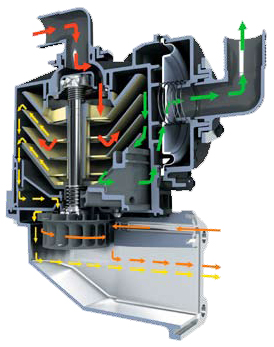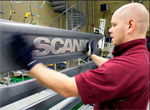The truck trick
Soot and oil residues are quickly disappearing from Scania’s engines, thanks to the truck manufacturer’s move towards a greener agenda – a journey it is making with the help of Alfdex, a pioneer in dealing with the cleaning of crankcase gases.
DATE 2023-11-28 AUTHOR Alexander FarnsworthAs global emissions standards become more stringent around the world, truck manufacturers such as Sweden’s Scania are increasingly looking at new technological solutions that will allow them to comply with these new standards and at the same time enable them to become environmental leaders in their own right.
Much of the environmental emphasis for auto and truck manufacturers has been to reduce carbon dioxide emissions that are passed into the atmosphere through tailpipe emissions, either by building more efficient engines or by building engines that run on alternative fuels such as ethanol.
But trucks and buses, especially heavy trucks, also emit what are known as crankcase gases. These are gases that are formed during combustion, and they leak down into the crankcase via gaps between the cylinder walls and the piston rings. To prevent pressure building up inside the crankcase, these gases must be vented in a continuous flow. Until recently, diesel crankcase gases, with all their soot and oil, were simply discharged into the atmosphere or onto the road. But the situation is under pressure to change.
Technology meeting new legislation
In 2004, South Korea was the first country to legislate against diesel crankcase gas emissions, followed by Japan in 2005 and the United States in 2007. Europe is expected to follow in a few years.
 In 2002, however, Alfa Laval and Haldex, a leading provider of solutions to the global automotive industry, were already trying to solve the problem. They joined forces to form Alfdex, a new company to develop technology to clean up diesel crankcase gas emissions – an agreement that the parent companies said combined "Alfa Laval’s expertise in separation technology with Haldex’ capabilities in enhancing vehicle performance."
In 2002, however, Alfa Laval and Haldex, a leading provider of solutions to the global automotive industry, were already trying to solve the problem. They joined forces to form Alfdex, a new company to develop technology to clean up diesel crankcase gas emissions – an agreement that the parent companies said combined "Alfa Laval’s expertise in separation technology with Haldex’ capabilities in enhancing vehicle performance."
The new company developed an oil mist separator, a device that uses centrifugal separation to remove both oil droplets and soot from vent gas and return them to the oil sump via a drainpipe. The design is based on Alfa Laval’s industrial centrifugal separator technology that has been used for years. "The global market potential for the Alfdex system is estimated at more than SEK 1 billion per year," says Alfdex Chairman Ulf Granstrand.
The device went on the market in late 2004 and early 2005, and Alfdex is expecting 2008 sales of its separator to double, compared with 2007. With its existing customers – Scania, DaimlerChrysler, International Navistar, Detroit Diesel and Volvo RVI /Mack – Alfdex expects to produce 1 million separators over a period of three years, according to Alfdex CEO Mats Ekeroth.
Joint development
Meanwhile, Scania first introduced the Alfdex® Oil Mist Separator in its trucks back in 2005, says Stefan Fors, Scania’s research engineer in crankcase ventilation. Today, about 15,000 Scania trucks per year are outfitted with this new technology.
"We are still more or less in the introductory phase," says Fors. "And the Alfdex Oil Mist Separator is still just an add-on accessory. But that will change. Currently all of our Euro 5-compliant trucks have the Alfdex system installed."
Alfdex conceived the oil mist separator as a standard product, but, says Fors, Scania was very involved in developing the separator for its own engines as well. While the actual separator is now a standard product, truck manufacturers still want the flexibility of choosing where on an engine block to place the Alfdex unit. So the interface housing that is attached to the engine block remains custom adapted.
"There were things we needed to change during development," he says. "Scania engines have their own temperatures and vibrations. And we wanted Scania quality on our trucks. In addition, we had a very short deadline when we were working on trucks to deliver to Japan and South Korea, so we had to work very closely with Alfdex."
 Fors admits that it is difficult to put a concrete value on the environmental improvement resulting from using an Alfdex Oil Mist Separator on a Scania truck. "It is more about the soft factors, like the way it is appreciated by customers and that it can help increase the motor’s lifetime," he says. "Scania wants to have a good environmental profile, and we wanted to offer this possibility without compromising Scania quality." Says Leif G Larsson, customer project coordinator at Alfa Laval, "The development and customization of the Alfdex® Oil Mist Separatorfor Scania was a successful and highly technical partner-ship, with technological advances that benefited both parties, and the system helps the environment in a very important way."
Fors admits that it is difficult to put a concrete value on the environmental improvement resulting from using an Alfdex Oil Mist Separator on a Scania truck. "It is more about the soft factors, like the way it is appreciated by customers and that it can help increase the motor’s lifetime," he says. "Scania wants to have a good environmental profile, and we wanted to offer this possibility without compromising Scania quality." Says Leif G Larsson, customer project coordinator at Alfa Laval, "The development and customization of the Alfdex® Oil Mist Separatorfor Scania was a successful and highly technical partner-ship, with technological advances that benefited both parties, and the system helps the environment in a very important way."
This is how the separator works
Pop the hood on a Scania Euro 4-class truck, or rather tilt the cab forward to reveal its turbocharged diesel engine, and you can clearly see the Alfdex® Oil Mist Separator.
About the size of a household toaster, the Alfdex® Oil Mist Separator is mounted on the engine block. On one side unclean crankcase gases enter the oil pressure-driven separator and clean air exits another pipe. At the same time oil and soot particles drop to the engine sump.
The clean air is then led back to the air intake manifold where it re-enters the engine to minimize exhaust emissions. Without any cleaning, it is estimated that a typical long-distance truck would spill 25-30 litres of engine oil per year. If multiplying a low count of 15 litres of oil savings per truck with 1 million Alfdex separators (the total number of separators expected to be produced throughout 2010) it corresponds to an oil-spill reduction of 15,000 cubic metres or about 22,000 bathtubs in 2010.
The Alfdex separator is like a dishwasher that cleans its own water. But it is anything but a household appliance. For one thing, the unit is totally sealed and never needs maintenance or service during the service life of a truck diesel engine. This is known in the business as "Fit and Forget."
The Alfdex® Oil Mist Separator is driven by an oil turbine. This in turn is driven by the surplus of pressured lubricant oil normally available in diesel engines. This turbine, fitted in the bottom housing of the Alfdex unit, spins a centrifugal rotor, and a separator drain feeds the oil back to the sump.
The centrifugal rotor has a batch of conical-shaped discs stacked on top of each other, and it is here that the separation takes place. The discs rotate at between 6,000 and 8,000 rpm. In this environment, the dirty crankcase gases are subject to centrifugal forces that are more than 2,500 times greater than the earth’s gravity, thereby forcing the oil droplets to separate out from the gas.
In addition to being a separator unit, the discs work as a fan, extracting the gases from the crankcase and thereby avoiding a pressure drop in the unit.

